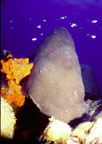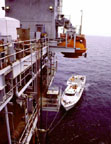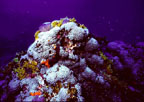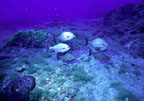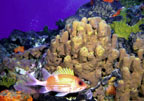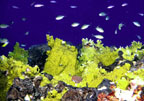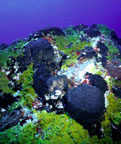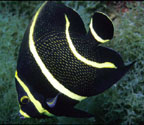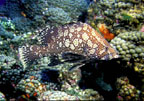|
|
Error processing SSI file |
Click on any image for an enlarged view
|
|
Habitats
|
The Flower Garden corals grow on top of geological structures called salt domes, or salt diapers. Millions of years ago, when the Gulf of Mexico click image for more...(photo: Dr. Tom Bright) |
|
|
This photograph depicts the landscape of the West and East Flower Garden Banks. It illustrates the high coral coverage (around 50%), click image for more...photo: Frank and Joyce Burek) |
|
|
At night, corals compete for space by reaching out to their neighbors with long filaments which literally dissolve the coral tissue next door, click image for more... (photo: Frank and Joyce Burek) |
|
|
An example of the reefscape at the Flower Gardens - brain coral (Diploria strigosa), exposed reef rock, branching tube sponge click image for more... (photo: Frank and Joyce Burek) |
|
|
Many mushroom shaped projections, such as this one, occur naturally at the Flower Gardens, and other coral reefs. This is a natural process called bioerosion, where reef organisms (sponges, etc.) slowly remove the reef rock underneath living click image for more... (photo: Frank and Joyce Burek) |
|
|
Great star coral (Montastraea cavernosa) is easy to identify because of the size of the polyps - as large as the end of a person's thumb. It is one of four species of Montastraea found at the Flower Gardens. It is one of the participants in the mass click image for more... (photo: Dr. Stephen Gittings) |
|
|
This picture clearly illustrates the two different species of brain coral found at the Flower Gardens. In the foreground is boulder brain coral click image for more... (photo: Frank and Joyce Burek) |
|
|
Platforms in the Gulf of Mexico are a favorite dive site for adventurous SCUBA divers. This production platform (HI389A), located just one mile east of the East Flower Garden Bank, is home to a diverse and rich biological community - more so click image for more... (photo: Frank and Joyce Burek) |
|
|
Tesselated blenny (Hypsoblennius invemar), left and a seaweed blenny (Parablennius marmoreus) right - these are often seen poking click image for more... (photo: Frank and Joyce Burek) |
|
|
Stetson Bank is lined on one side by a row of high relief pinnacles - a couple of which are covered with ten-ray star coral (Madracis decactis). click image for more... (photo: Frank and Joyce Burek) |
|
|
Another view of Stetson Bank. Intermingled in between the coral colonies are the many sponges found at Stetson Bank, click image for more... (photo: Frank and Joyce Burek) |
|
|
Stetson Bank is dominated by fire coral (Millepora alcicornis), algae, and many species of sponges. The front side of the pinnacles drop down steeply to depths beyond scuba diving click image for more... (photo: Frank and Joyce Burek) |
|
|
Stetson Bank is dominated by fire coral (Millepora alcicornis) and sponges, including this branching tube sponge (Pseudoceratina click image for more... (photo: Frank and Joyce Burek) |
|
|
The fire coral is a mustard color tipped with white, and is definitely on every divers list of what not to touch. The stinging cells, called click image for more... (photo: Frank and Joyce Burek) |
|
|
A colorful assortment of fire coral (Millepora alcicornis) and sponges are a photographer's dream at Stetson Bank. Some species of sponge represented here are the black-ball sponge (Ircinia strobilina), a type of red encrusting sponge, and click image for more... (photo: Frank and Joyce Burek) |
|
|
This french angelfish (Pomacanthus paru) is in a intermediate stage between juvenile and adult - the stripes from the juvenile stage are still very visible, as are the yellow outlines of the individual scales of the adult. click image for more... (photo: Frank and Joyce Burek) |
|
|
The marbled grouper (Epinephelus inermis) is always a treat to see during a trip to the Flower Gardens. They are usually rather shy animals, and are often found in deeper areas click image for more... (photo: Joyce and Frank Burek) |
|
|
This creole-fish (Paranthias furcifer) stops and spreads its fins out, and sometimes opens its mouth and puffs out its (photo: Frank and Joyce Burek) |






